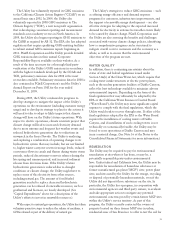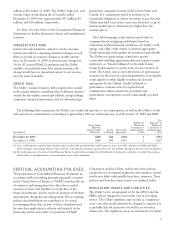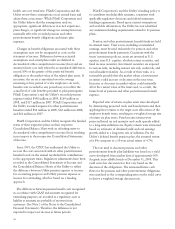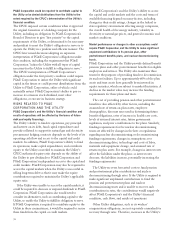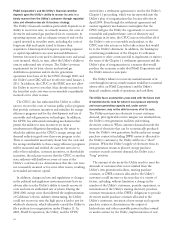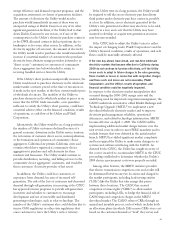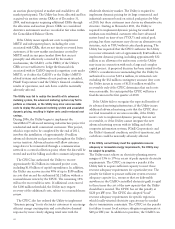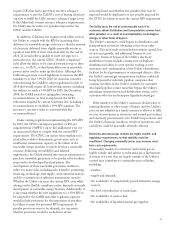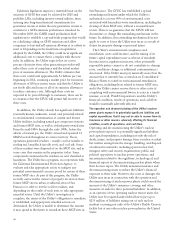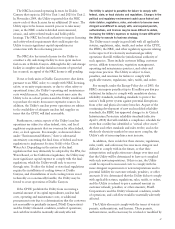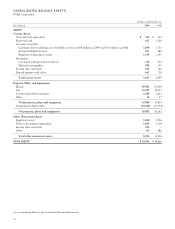PG&E 2009 Annual Report Download - page 45
Download and view the complete annual report
Please find page 45 of the 2009 PG&E annual report below. You can navigate through the pages in the report by either clicking on the pages listed below, or by using the keyword search tool below to find specific information within the annual report.energy efficiency and demand response programs; and the
acquisition, retirement, or closure of generation facilities.
The amount of electricity the Utility would need to
purchase would immediately increase if there were an
unexpected outage at Diablo Canyon or any of its other
significant generation facilities, if the Utility had to shut
down Diablo Canyon for any reason, or if any of the
counterparties to the Utility’s electricity purchase contracts
or the DWR allocated contracts did not perform due to
bankruptcy or for some other reason. In addition, as the
electricity supplier of last resort, the amount of electricity
the Utility would need to purchase also would immediately
increase if a material number of customers who purchase
electricity from alternate energy providers (referred to as
“direct access” customers) or customers of community
choice aggregators (see below) decided to return to
receiving bundled services from the Utility.
If the Utility’s short position unexpectedly increases, the
Utility would need to purchase electricity in the wholesale
market under contracts priced at the time of execution or,
if made in the spot market, at the then current market price
of wholesale electricity. The inability of the Utility to
purchase electricity in the wholesale market at prices or on
terms that the CPUC finds reasonable, or in quantities
sufficient to satisfy the Utility’s short position, could have
a material adverse effect on the financial condition, results
of operations, or cash flow of the Utility and PG&E
Corporation.
Alternatively, the Utility would be in a long position if
the number of Utility customers declined because of a
general economic downturn in the Utility service territory,
the restoration of customer direct access, municipalization,
or the formation and operation of community choice
aggregators. California law permits California cities and
counties which have registered as community choice
aggregators to purchase and sell electricity for their
residents and businesses. The Utility would continue to
provide distribution, metering, and billing services to the
community choice aggregators’ customers, and would be
those customers’ electricity provider of last resort.
In addition, the Utility could lose customers, or
experience lesser demand, because of increased self-
generation. The risk of the loss of customers and decreased
demand through self-generation is increasing as the CPUC
has approved various programs to provide self-generation
incentives and subsidies to customers to encourage
development and use of renewable and distributed
generating technologies, such as solar technology. The
number of the Utility’s customers also could decline due to
stricter GHG regulations or other state regulations that
cause customers to leave the Utility’s service territory.
If the Utility were in a long position, the Utility would
be required to sell the excess electricity purchased from
third parties under electricity purchase contracts, possibly
at a loss. In addition, excess electricity generated by the
Utility’s own generation facilities may also have to be sold,
possibly at a loss, and costs that the Utility may have
incurred to develop or acquire new generation resources
may become stranded.
If the CPUC fails to adjust the Utility’s rates to reflect
the impact of changing loads, PG&E Corporation’s and the
Utility’s financial condition, results of operations, and cash
flows could be materially adversely affected.
If the new day-ahead, hour-ahead, and real-time wholesale
electricity markets that became effective in California during
2009 do not continue to function effectively, or if the Utility
incurs costs to adapt to future changes to the rules governing
these markets or losses in connection with congestion charges
and these costs and losses are not recoverable, PG&E
Corporation’s and the Utility’s results of operations and
financial condition could be negatively impacted.
In response to the electricity market manipulation that
occurred during the 2000–2001 energy crisis and the
underlying need for improved congestion management, the
CAISO undertook an initiative called Market Redesign and
Technology Upgrade (“MRTU”) to implement a new
day-ahead wholesale electricity market and to improve
electricity grid management reliability, operational
efficiencies, and related technology infrastructure. MRTU
became effective on April 1, 2009. The CAISO will be
implementing additional market design features over the
next several years in order to meet FERC mandates and to
include features that were deferred in the initial market
launch. MRTU has added significant market complexity
and has required the Utility to make major changes to its
systems and software interfacing with the CAISO. As
directed by the CPUC, the Utility has sought recovery of
the costs it incurred to accommodate MRTU in the CPUC
proceeding established to determine whether the Utility’s
2009 electric procurement costs were properly recorded.
Among other features, the MRTU initiative provides
that electric transmission congestion costs and credits will
be determined between any two locations and charged to
the market participants, including load-serving entities
(“LSEs”) like the Utility that take energy that passes
between those locations. The CAISO has created
congestion revenue rights (“CRRs”) to allow market
participants, including LSEs, to hedge the financial risk of
CAISO-imposed congestion charges in the MRTU
day-ahead market. The CAISO releases CRRs through an
annual and monthly process, each of which includes both
an allocation phase (in which LSEs receive CRRs at no cost
based on the customer demand or “load” they serve) and
41


